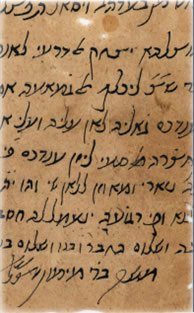The Friedberg Genizah Project

Significance
 ntil FGP created its online research platform and made Cairo Genizah manuscripts accessible to the world, a scholar wishing to study a specific folio had to travel to one university to view a fragment of it, and then to a different university (often in a different country or continent) to view another section of the same page. Since there was no complete inventory or catalog of all Genizah materials, this was conditional, of course, on the scholar happening to know whether the other sections of the page even existed, and if they did, where they were located. Add to this chaotic situation the manuscripts' poor physical condition and, in some cases, virtual illegibility, and it is no wonder that so little is known about the Cairo Genizah even though it was discovered almost 120 years ago.
ntil FGP created its online research platform and made Cairo Genizah manuscripts accessible to the world, a scholar wishing to study a specific folio had to travel to one university to view a fragment of it, and then to a different university (often in a different country or continent) to view another section of the same page. Since there was no complete inventory or catalog of all Genizah materials, this was conditional, of course, on the scholar happening to know whether the other sections of the page even existed, and if they did, where they were located. Add to this chaotic situation the manuscripts' poor physical condition and, in some cases, virtual illegibility, and it is no wonder that so little is known about the Cairo Genizah even though it was discovered almost 120 years ago.
FGP was established precisely to facilitate and rejuvenate Genizah research by locating, identifying, cataloging, transcribing, translating, digitally photographing and publishing ../images/ of all the manuscripts online.
To this end, FGP works in close collaboration with university libraries worldwide, at times providing the funding required by the libraries to perform these tasks on their own, but frequently carrying out the work Agreements are signed giving FGP the right to publish the material online.
Manuscripts are digitized at 600 DPI resolution (as required by the Research Libraries International Organization), thus making the computerized image clearer than the original manuscript itself by allowing for very powerful magnification.
The academic communities' appreciation of FGP is evidenced by virtue of the fact that prestigious university libraries are eagerly signing copyright agreements with FGP in order to participate in the project and share their precious Cairo Genizah collections with the rest of the world.
Before FGP, there was no unified, efficient Genizah "channel" through which scholars could share knowledge with their colleagues; research teams in universities worldwide were working in isolation. FGP has become this "channel," creating important and unprecedented collaboration between academic institutions and scholars, resulting in the creation of more qualitative and cost-effective research of the Cairo Genizah.
Image: Letter in the Rambam's hand with his signature, Late 12th Century; Cambridge University Library T-S 12.192